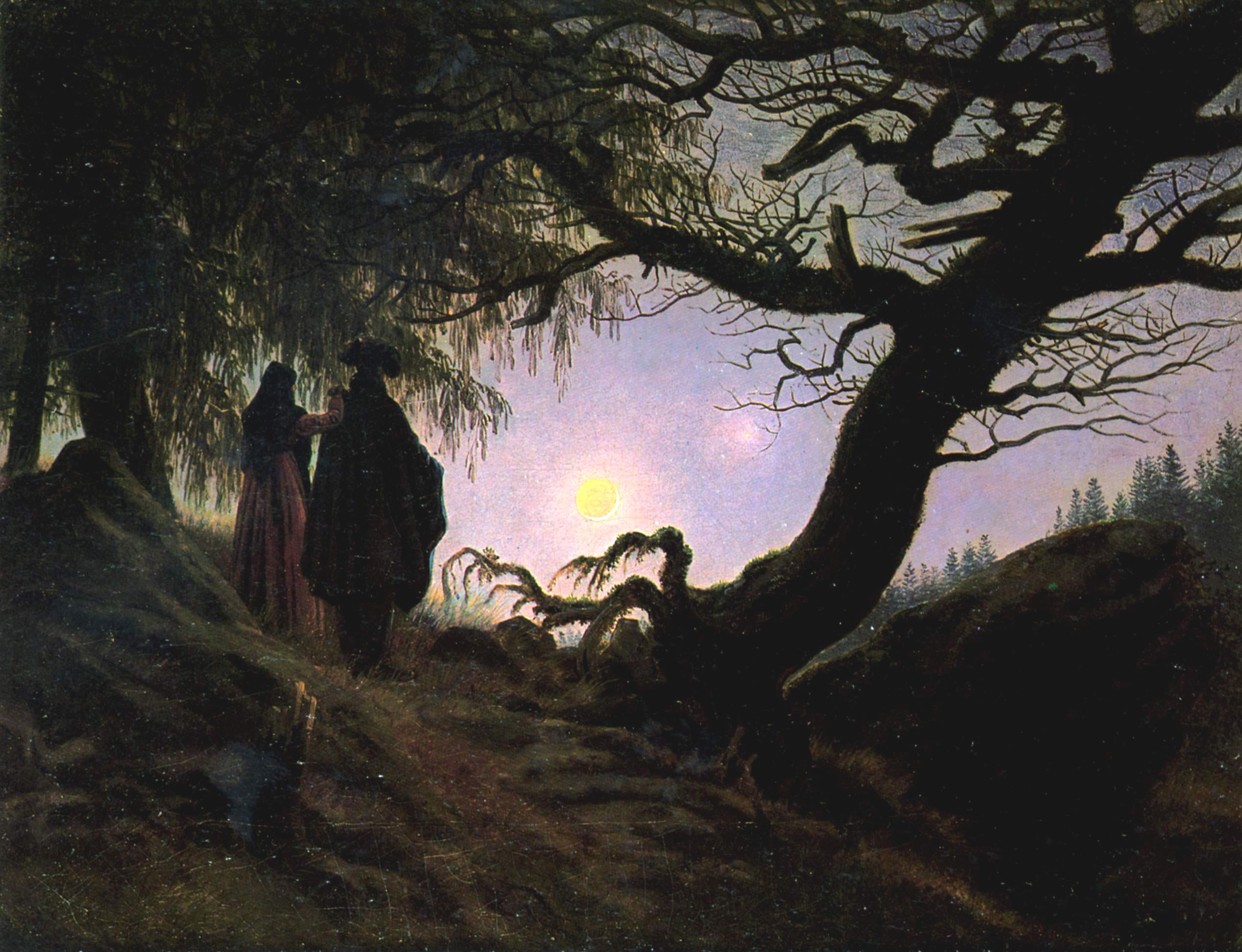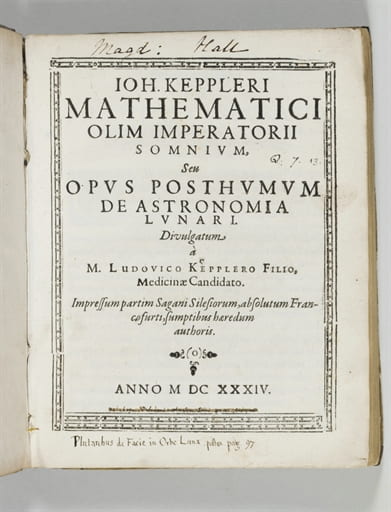by guest contributor Nicholas Bellinson
One Bohemian night in 1608, the Imperial Mathematician gazed up at the moon and the stars. In the seven years since he had received that title, Johannes Kepler had discovered many things about these celestial bodies, some true and some (as Hesiod said) like the truth: that planets moved around the sun, not the earth; that they moved in ellipses, not perfect circles; that they were enormous magnets – to name a few. The following year, he would publish these discoveries as his New Astronomy, a book which would make his name a fixed star in the firmament of science. On this particular night, however, a different book was on Kepler’s mind. His curiosity had been aroused by popular historical comparisons to the current troubles between Emperor Rudolph and his brother, the Archduke Matthias; while investigating Bohemian legends, Kepler had come across the story of Libuše, a prophetess associated with the founding of Prague and “most famous for her skill at magic.” With Libuše and the moon swimming in his head, Kepler got ready for bed and fell into an unusually deep sleep.
Kepler circulated but never published a written account of the bizarre dream which ensued; after his death, his penniless wife persuaded his destitute son (an aspiring doctor) to complete and publish the work. For us, the text is marvelously rich in astronomical, literary, and sociological significance. He dreamed that he was reading a book—a realistic enough start—about an Icelandic boy named Duracotus. When the curious boy cuts open one of the pouches of herbs his mother Fiolxhilda has promised to a skipper, she sells him instead and keeps the money; the skipper takes the boy and sails for Norway. Eventually, Duracotus is charged with delivering some letters to Tycho Brahe (Kepler’s predecessor as the Imperial Mathematician), and the man becomes his mentor. Having made startling progress in his astronomical studies (though with only middling Danish) Duracotus sails home to his mother. Fiolxhilda is overjoyed at Duracotus’s astronomical knowledge, and Duracotus is surprised to discover that his mother knows as much as he. She explains that she is visited by nine spirits of the moon (called by them “Levania”) and conjures one to expatiate on his homeworld.

Caspar David Friedrich, “Man and Woman Contemplating the Moon,” 1835 (Alte Nationalgalerie, Berlin).
What follows in Kepler’s dream is a detailed astronomical account of Levania punctuated with fantastic and often humorous details about the journey from one to the other realm. A man who wishes to be whooshed away to Levania, for example,
…must first be tranquilized with narcotics and opiates and stretched out by the limbs, lest the body be separated from the rectum or the head from the body, but so that the force may be divided among the individual limbs. Then begins a new problem, namely a great chill and difficulty breathing… to counteract which we place wet sponges at his nostrils.
Voicing both fact and fantasy, the Levanian spirit spoke to serious issues in current astronomical debates by providing desiderata like the length of the lunar day; at the same time, Kepler managed to translate his brand-new astronomy into Levanian terms—that is to say, from the point of view of an observer on the moon. In such terms, the work exhibits a daring relativism, suggesting not only (with Copernicus) that the planets revolve around the sun, but that scientific designations are contingent rather than absolute. The earth is called “Volva”—from the Latin root volv– ‘turn, revolve’—and contemplation of it is a favorite activity on Levania; Levanian geographers and astronomers subdivide the surfaces of the earth and the moon differently from their terrestrial counterparts. “Even if all Levania has the same views of the fixed stars as we do,” Kepler posited, setting up a dizzying thought experiment, “yet it sees [observat] planetary motions and quantities very different from those which we see here [sc. on earth], so that the mode of reckoning [ratio] of their whole astronomy is entirely different [sc. from ours].”
At the end of the dream, Kepler awoke with his head on a cushion and his body wrapped in blankets, a suggestion of precautions for the journey to Levania – also a complicated and literary gesture which points either to the influence of the waking world on dreams or to a claim that the dream actually took place. Kepler’s own, copious notes to the text preserve this ambiguity while treating the reader to certain authorial insights: “I’ve forgotten the real reason for this number,” he wrote, glossing the nine spirits, “… I’m certain I was thinking of Urania from the number of the muses or of Astronomy out of the nine sciences.” He chose a remote place like Iceland “in order to imitate the philosophers in this genre of writing.” In fact, the notes tell us as much about what Kepler was reading as about what he was writing. Cicero’s Dream of Scipio, Plato’s tale of Atlantis, and Lucian’s True Story are all named as influences, but as for Plutarch’s treatise on the face of the moon, Kepler had not yet read it, and later marveled “by what chance our dreams or tales [somnia seu fabulae] accorded so exactly.”
The notes also contain a tirade against the dogmatism of Augustinians in relation to astronomy. One wonders at the wisdom of this, given that the text (in an earlier form, without Kepler’s notes) may have been a factor in accusations of witchcraft against Kepler’s mother. The woman, whom Kepler nastily described as mean-spirited, illiterate, and a chatterbox, could not much have resembled the sage Fiolxhilda, but to contemporary readers, Kepler’s dream could have seemed autobiographical as well as fanciful and didactic. The Copernican matter was inflammatory to begin with, but to mix it with magic probably increased the violence of certain readers’ reactions.
Even in the time of trigger warnings, the extent to which seventeenth-century readers believed in the power of books will continue to surprise and enchant us. Kepler’s reading brought about his dream; in his dream, he read a book which he suggests transported him to the moon. For centuries, people had imagined Vergil as a magician (and told the most spectacular tales about his magical feats) thanks in part to a few lines of the witch’s song in his eighth eclogue: “spells can bring down the moon from the heavens,” Vergil wrote, and in the notes to his dream, Kepler quoted him, though he nearly brought down the heavens instead.
Nicholas Bellinson is a second-year graduate student in the Committee on Social Thought at the University of Chicago. He has studied Renaissance literature, art history, and history of science. He is writing his dissertation on Shakespeare.




October 27, 2015 at 6:09 am
Reblogged this on The Somnium Project.